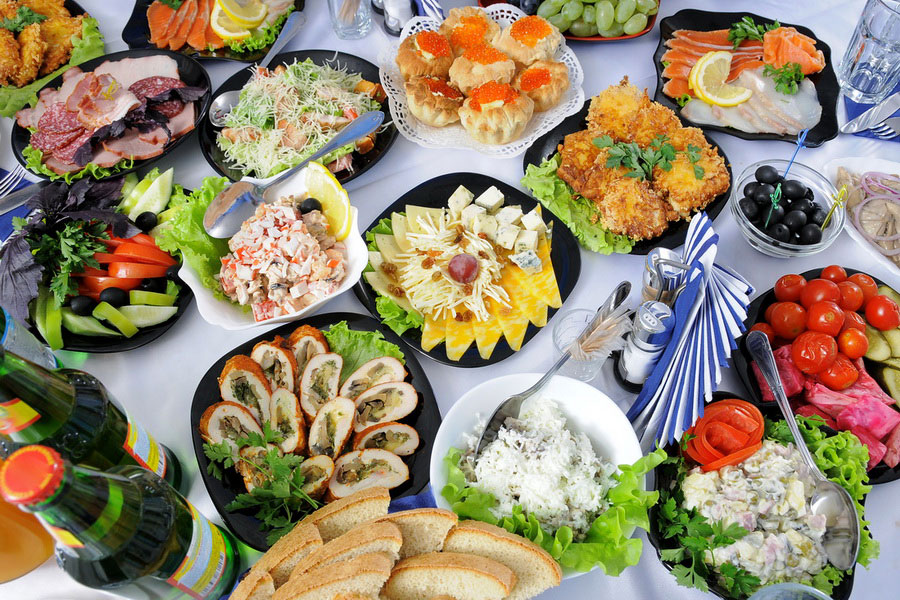 Served festive table
Served festive table
From time immemorial, traditional Russian food has consisted of rich dishes and generous portions, a fact captured in local fairy tales which speak of “a feast large enough to feed the planet.”
Russian cuisine did not firmly take shape until the late 19th-early 20th centuries, yet since that time it has been rivaling cookery from around the world. Distinguished by the simplicity of its preparation and straightforward ingredients, it offers a surprisingly exquisite taste. The region’s harsh climate and natural resources have played a central role in the popularity of hot soups, hearty porridges, succulent meat dishes, diverse cheeses and fresh baked goods.
Russia is a massive land populated with many nationalities, and its cuisine naturally reflects this diversity. Thus, Russian food in Moscow will vary widely from that found in Vladivostok, Sochi or Kazan, which is all the more reason to travel extensively and sample as much of it as possible!
Russian Dairy Products
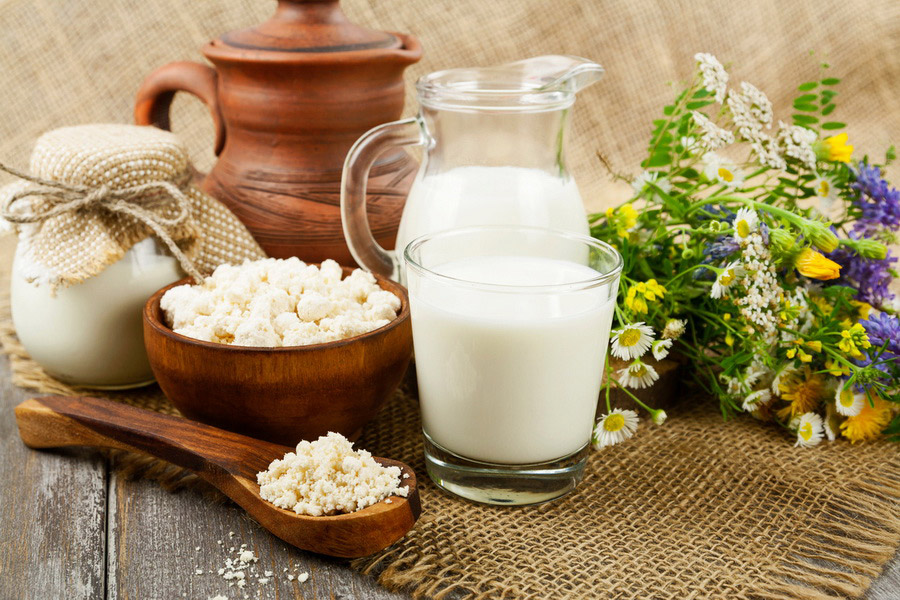 Cottage cheese and sour cream
Cottage cheese and sour cream
Russian people have long harbored a special love for dairy products, which are an integral part of the local diet. Milk in particular is a staple drink and regarded as essential for health: For many years in Russia, a cow was jokingly referred to as a wet nurse, and even today milk remains a symbol of health.
Baked milk also became popular among Russians, for it has a longer shelf life than fresh milk yet does not lose its taste or healthful properties. To prepare baked milk the traditional way, fresh milk should be boiled in an earthen pot and left in a cooling oven until early morning. Ryazhenka, a traditional fermented milk made from baked cow's milk, is a spin-off of this product.
Cottage cheese is a very common filling in Russian baked dishes, for when combined with sugar, salt, vanilla, butter, dried fruit or chocolate glaze, it makes a truly mouthwatering treat.
Sour cream likewise pairs well with many traditional Russian foods, but is best known as the perfect accompaniment for borscht, a classic and beloved beetroot soup.
Russian Porridge
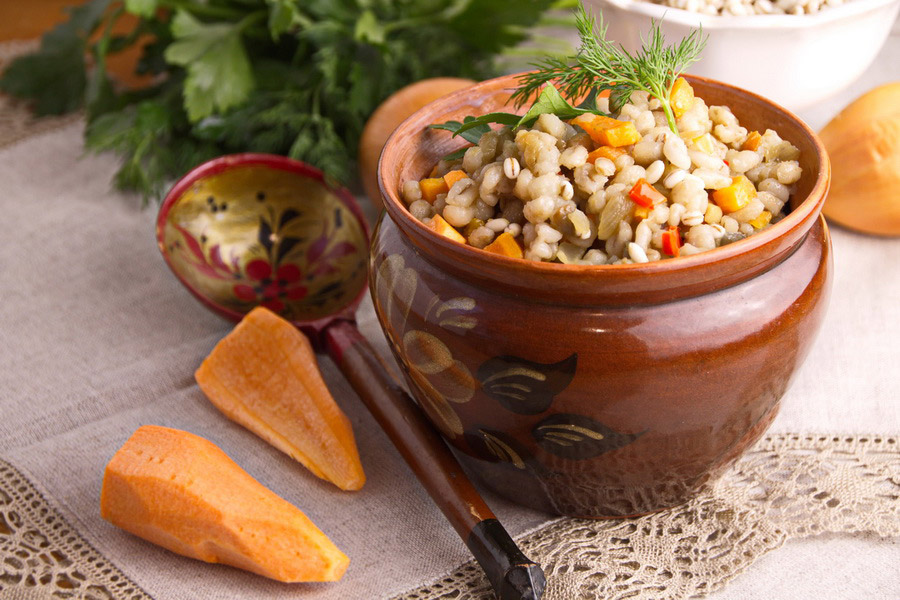 Barley porridge
Barley porridge
The Russians’ love for their porridge can be ascertained by the many proverbs dedicated to this staple. “You cannot feed a Russian peasant without porridge”, “Porridge is our mother”, “Buckwheat porridge is our mother, and rye bread is our father " all support the idea that porridge is one of the most popular foods in all Russia.
Russian porridge may be cooked with oats, buckwheat, millet, pea, wheat or semolina, the latter of which has been the queen of preschool breakfasts for generations. Often referred to as the food of heroes (and no doubt the local breakfast of champions), adults often tell children to eat porridge in order to grow big and strong.
Russian Meat Dishes
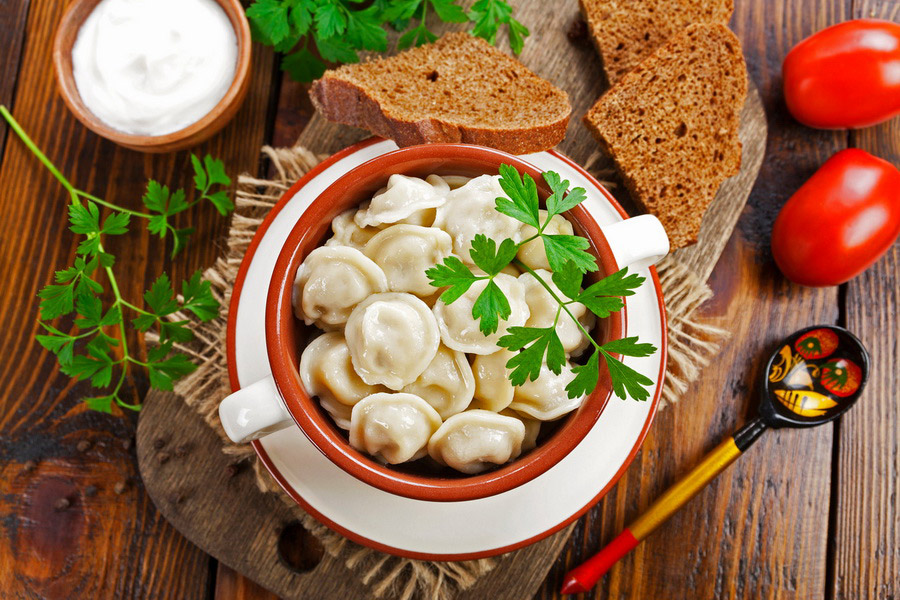 Dumplings
Dumplings
Meat dishes are essential to the common Russian dinner. As varied as they are hearty, they can include pork, beef, poultry or lamb. Topping the Russian food list, and for good reason, are roasts and juicy dumplings.
A Russian roast beef served with stewed potatoes and carrots could turn a vegetarian into a meat eater. Rumor has it that the Russian roast even holds a title of nobility, for when King Charles II tasted this delicacy, he was so impressed that he took his sword in hand and bestowed a royal title on the dish.
Boiled Russian pelmeni dumplings and their larger, steamed variety called manti are meat-filled delights which are both satisfying and easy to prepare, albeit a bit time-consuming. Pelmeni are traditionally served in a broth, while manti are dished up on a plate. When eaten hot with fresh sour cream, butter and dill or other greens, these dishes make a satisfying lunch or dinner.
Russian Fish Dishes
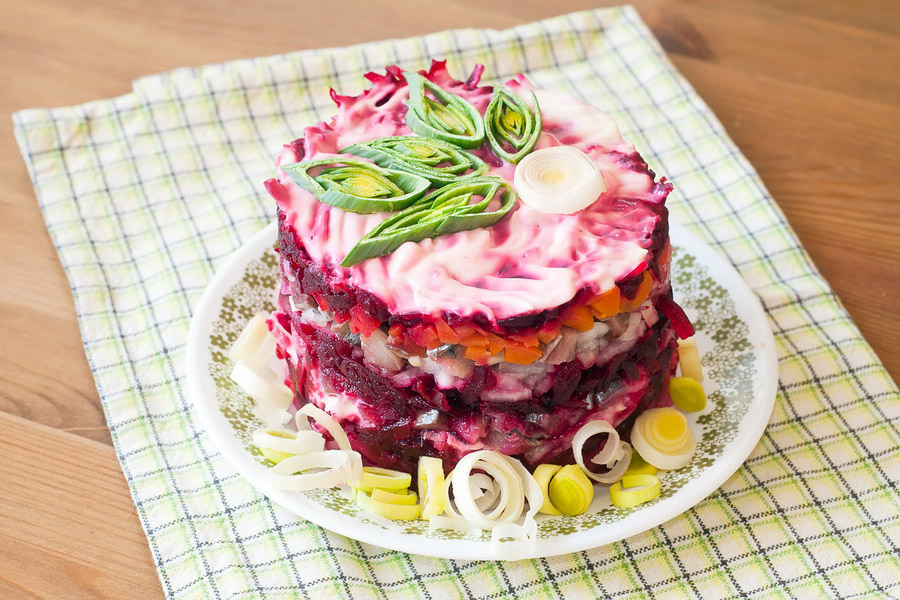 Salad "Herring under a fur coat"
Salad "Herring under a fur coat"
For Russians, fishing is not just an opportunity to reel in a catch but also a chance to find rest for the soul. Sturgeon, stellate sturgeon, beluga and sterlet are among the favored choices for Russian fish dishes. Ukha, a hot soup with a unique aroma and taste, is one of the most famous seafood dishes found on the Russian menu.
When cooking with fish, Russians favor sturgeon, stellate sturgeon, beluga and sterlet. Ukha, a hot soup with a unique aroma and taste, is one of the most famous seafood dishes found on the Russian menu. Sundry fish snacks are also extremely popular in Russia, particularly salted caviar. Layered fish salads will delight the eye and the palate, particularly the eggs, potatoes and fish found in Mimosa Salad and the creatively named Herring Under a Fur Coat, a conglomerate of potatoes, onions, carrots, beets and, of course, herring.
Russian Mushroom Dishes
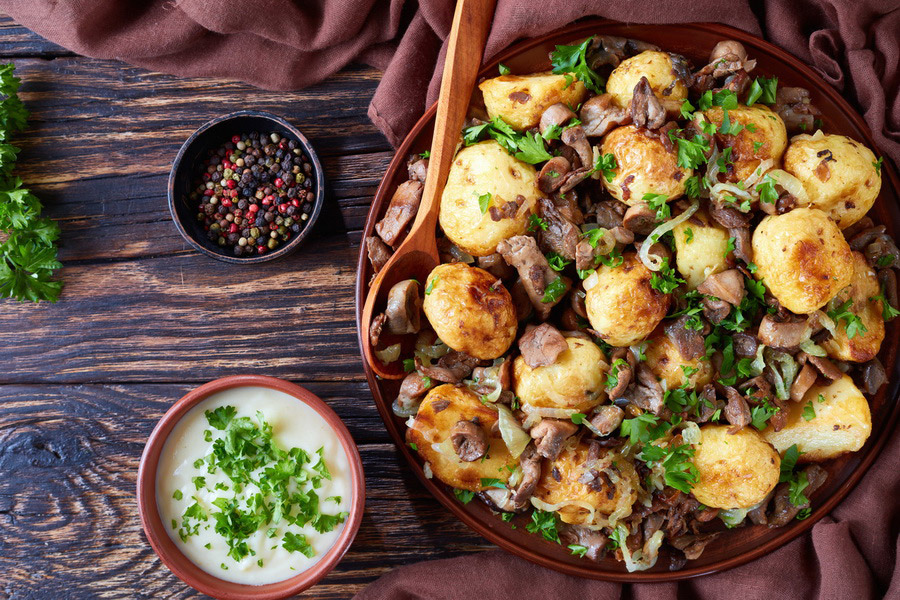 Fried potatoes with mushrooms
Fried potatoes with mushrooms
Russian mushroom dishes sprang from the historic pastime of mushroom and berry picking in the forest, once a favorite activity for many families. Rich in protein and carbohydrates and packed with nutrition, it is not surprising that mushrooms have won a special place in Russian national food.
Fried potatoes and mushrooms are among the most popular, filling and easy-to-prepare foods served at the Russian dinner table. In winter, mushroom soups and dried varieties are also common, while mushroom fillings serve as an easy add-in to pies and salads all year long.
Russian Baked Goods
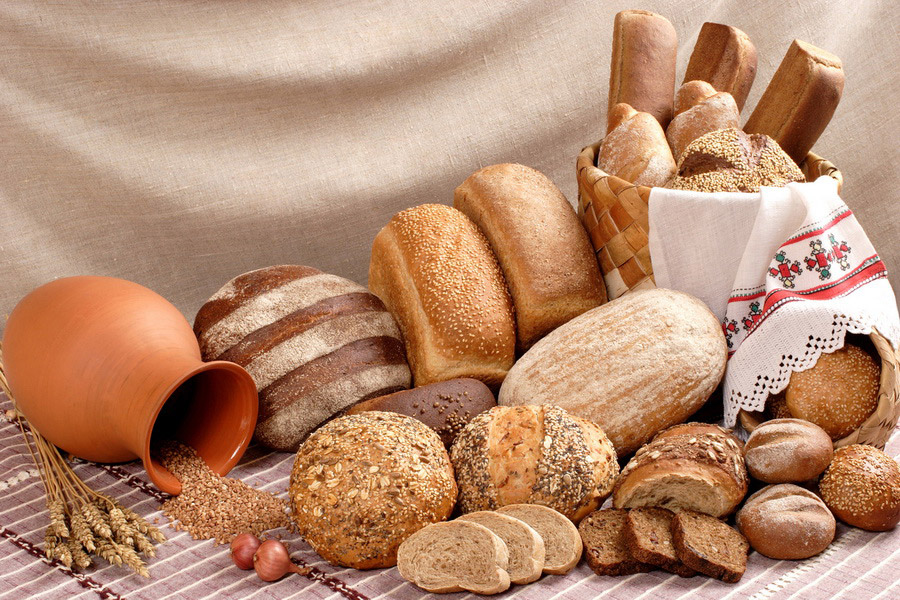 Bread
Bread
The sheer variety of baked goods which emerge from the Russian oven is nothing short of impressive!
Bread is a staple in Russian fare and treated with an almost sacred respect. As a local proverb sums it up, "Bread is the head of the table." In Russia, guests were traditionally greeted with bread and salt, the latter of which was not chosen at random: salt was very expensive, with one large bag equivalent to the price of a cottage! Salt and bread shared with a visitor thus emphasized the guest’s importance and the level of respect which the host had for him or her.
On holidays it was customary to serve pies, which are now a symbol of Russian national cuisine. The very word for pie (pirog) is associated with the word for feast (pir). The tender, flaky crust of Russian pies may be stuffed with all kinds of fillings, the most common being fruit, meat, mushrooms and vegetables.
Crepes are another beloved Russian baked good which are enjoyed year-round. This Russian comfort food may be filled with savory mushrooms or minced meat or with a sweet cottage cheese or berry filling. Crepes are usually served with a slathering of sour cream, honey or jam. The batter for Russian pancakes is nearly identical to that for crepes, yet pancakes are thicker and smaller. They are sometimes prepared with tvorg, a local cottage cheese variety.
When speaking of Russian desserts and pastries, gingerbread must not be overlooked. In past times they were given as gifts or baked for weddings and christenings, but today are more commonplace. Gingerbread from the Russian city of Tula, known for its elegant national prints and melt-in-your-mouth texture, is the most sought-after variety.
Russian Holiday Foods
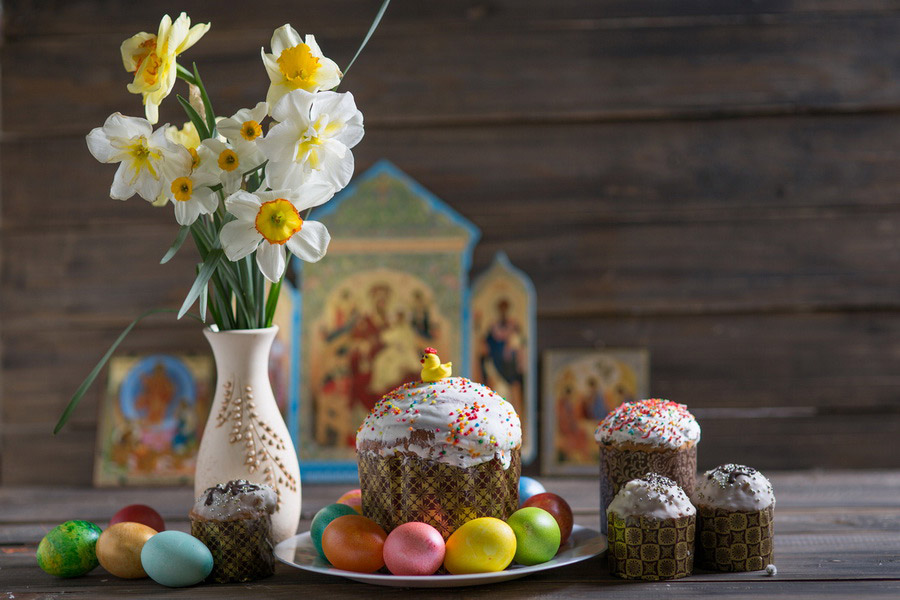 Easter cakes
Easter cakes
Russian holiday foods and other delicacies reserved for special events are referred to locally as ceremonial foods. Traditionally, weddings were celebrated over several days, during which time guests would be generously treated to a banquet. Crowning the Russian wedding feast was a large, round loaf of bread called karavay (koravai) which was imprinted with intricate patterns. The loaf was customarily divided into portions and distributed to each guest. A common main course for the wedding meal was stuffed goose, with apples, rice or buckwheat used as minced meat.
During Maslenitsa, a weeklong religious holiday whose very name is derived from the Russian word for oil (maslo), the making and consumption of crepes is central to the celebration. For Easter, special raisin cakes called kulich and a delicate cottage cheese-based dessert known as pashka make lovely (and tasty) centerpieces.
Yet another Russian food popular during holidays is kutia, a wheat or rice porridge dressed up with honey, dried fruit and nuts. This Russian dessert is typically prepared for commemoration services and religious holidays, especially Christmas.
Russian Pickled and Canned Goods
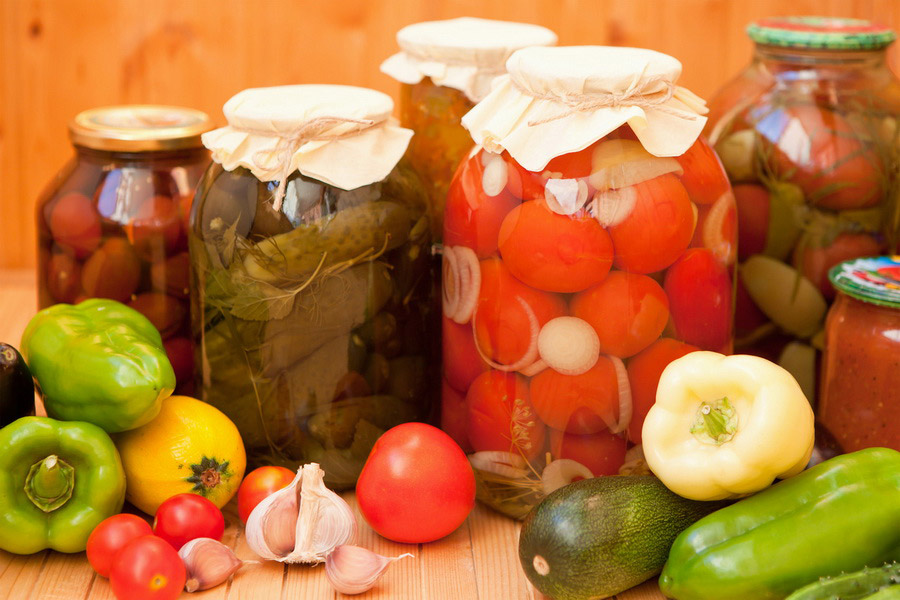 Pickled cucumbers and tomatoes
Pickled cucumbers and tomatoes
Russians would traditionally prepare for the harsh winter by canning pickled and fruit products in advance. The process of preparing Russian pickled and canned goods was so extensive that huge tubs would be used for the fermentation of various vegetables. Cabbage and cucumbers, which are grown in abundance and pair perfectly with many Russian dishes, remain the most popular of all.
Jam which was canned in summer or autumn became a staple companion of tea at winter meals. Since sugar was very expensive, honey or molasses was typically used to sweeten the jam. Different kinds of berries were also dried, to be used later as a filling for pies.
After canning was completed, the jars would be stored in cellars, basements or barns. The chore of canning for the winter evolved into a mini-holiday long ago, and to this day homemade jams, jellies and pickled products are still prepared by many Russian families.
Russian Soups
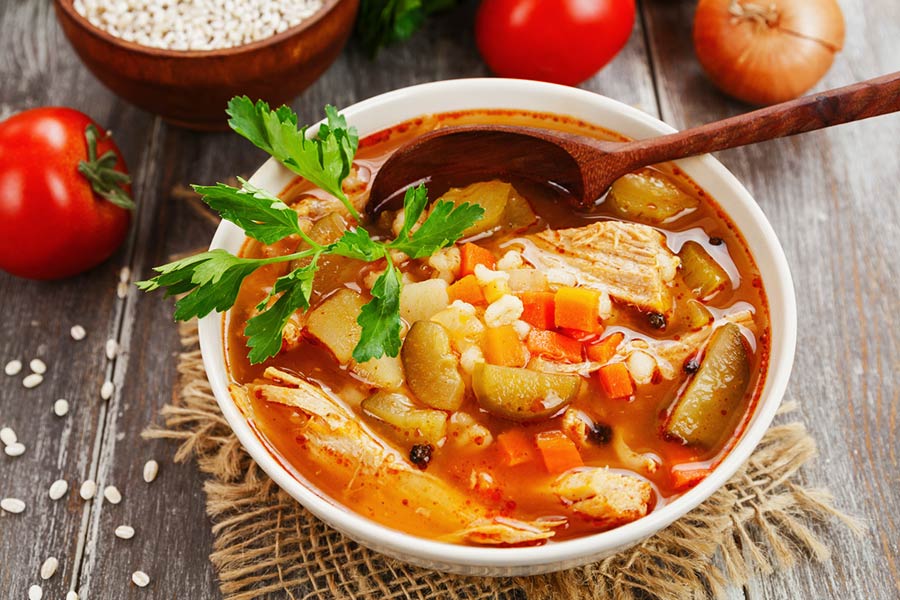 Rassolnik
Rassolnik
Russian soups are very famous in the world. Tradition Russian soup can be found in many cafes all round the world. Soup is a strong part of Russian traditions, Russians even invented special tube, in order to include soup to the diet of Russian cosmonauts. German Titov, the second Russian cosmonaut ate the first vegetable soup in cosmos.
Traditionally Russian soups are cold, light (made from vegetables, as a rule), solyanka, sauerkraut soup and fish soups.
Sauerkraut soup is the most famous Russian soup. Along with sauerkraut soup, Russians like different solyankas, rassolnik, fish chowder, noodle soups and summer cold soup okroshka.
Russian Condiments and Spices
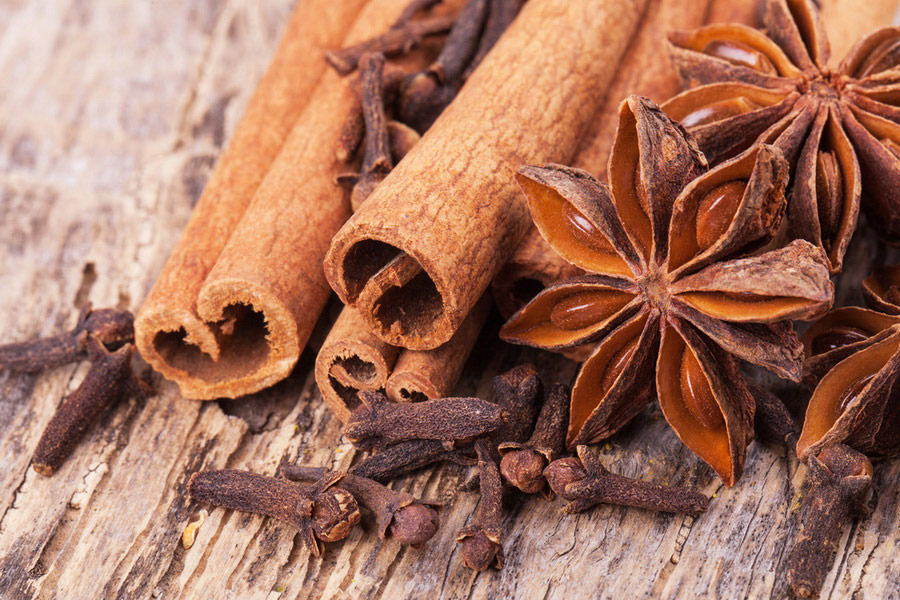 Russian condiments and spices
Russian condiments and spices
Many common Russian spices which have been added to soups and other dishes since ancient times are widely-recognized herbs which are simply known by unusual names in the country. For example, thyme is called chabrets and oregano is known as dushitsa. Other international seasonings which are not native to Russia were formerly replaced with creative substitutes: In lieu of lemon juice, sorrel, sour cherry and red currant were added to many dishes, and before the arrival of ginger and nutmeg, a root with a tart, burning taste called calamus was used. The name for gingerbread in Russian (pryanik) is actually derived from the word for spicy (pryaniy), since ginger, pepper and other spices were added to gingerbread for flavor.
Russian Drinks
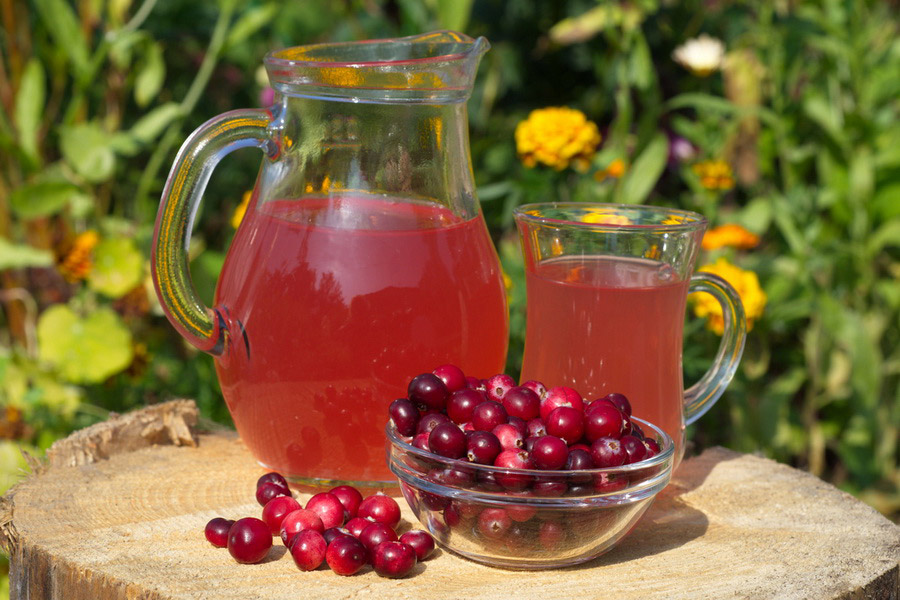 Cranberry mors drink
Cranberry mors drink
Russian drinks, much like traditional Russian foods, have taken shape over the centuries.
Vodka is an ever-present guest at most Russian celebrations. This strong alcoholic drink is traditionally downed from a shot glass in a single gulp and often accompanied by sauerkraut or other pickled goods.
Kvass, a fermented drink prepared from flour, water and malt and flavored with sugar, yeast, citric acid, raisins or similar ingredients, is another popular beverage. Mors is a sweeter traditional drink which is typically concocted from raspberries, lingonberries, cranberries or cherries.
Kompot and kisel are fruit-based drinks which in ancient times were reserved for special occasions and are now served at religious events and everyday gatherings. Although kisel may also be made from sour grain or oat, the fruit and berry varieties are the national favorites.
Instead of simply learning about the history of Russian cuisine, we invite you to come and plunge into the extraordinary world of traditional Russian food, a diverse menu filled with tempting aromas and delectable tastes!

